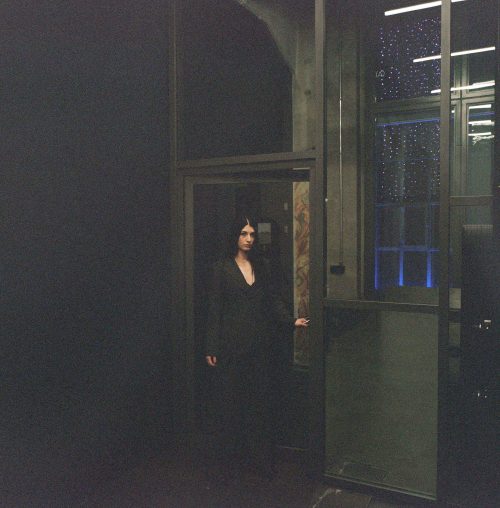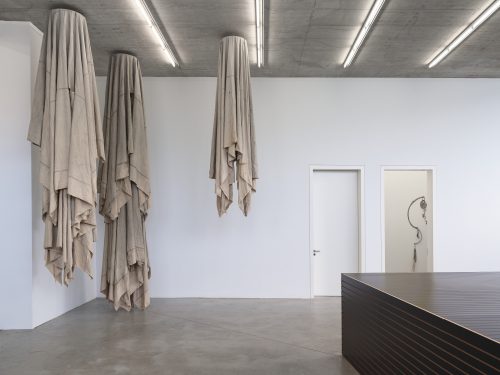
Olof Nimar
Green Letters

Green Letters, oil on canvas, each image 110x200cm
Advertisement














You can’t teach color from Cézanne, you can only teach it from something like this bubble-gum wrapper.
– Allan Kaprow
Green Letters is Olof Nimar’s third exhibition at Galleri Ping-Pong, following a solo presentation in 2016 and a group show in 2019. However, it can be said to be the artist’s first exhibition solely based on painting. Departing from an early practice in oil painting, Nimar has, through a primarily lens-based approach, held up a close-knit dialogue on overlapping concepts of painting and photography; investigating mechanisms of the photographic as they rub up against painterly discourses.
While Green Letters marks both something of a comeback and debut in the role of painter, the painter is an often-recurring protagonist in the artist’s storyline. In projects such as Giverny’s Generosity (2017), for which Nimar documented the sprouting flowers of Claude Monet’s famous Giverny gardens, or Landscape at Soumaya (2018), a photograph where a small landscape painting (also by Monet) is pictured as it is installed in the collection of the Soumaya Museum in Mexico City, painting returns continuously as the backdrop, scenography or baseline against which the artist weighs questions of photography’s illusory, multidimensional properties.
The exhibition centers around a series of twelve paintings, each fitted with sequences of the letter I. Borrowed from the dial of a long-since defunct cuckoo clock, hanging in the artist’s studio, the symbol serves both as a functional unit of speech and measure, as well as a signifier of the present sender. The chosen tall and slender format of the canvases furthers this play on scale. Here, numbers are architectural. Not only in their initial visual resemblance to columns, or other fundamental architectural elements, but also in their role in the infrastructure from which the exhibition unfolds.
To draft the show’s grammar, the artist mapped out all possible combinations of the sign through small pencil drawings. A process echoing in the remnants of thin graphite lines glimpsed at the border of each character. Layered fields of green painted in varying opacities, swiftly build depth, while generating 'negative' outlines of raw linen around each signifier. Repetition not only performs as possible variations of this lead motif but alludes to a spatial gauging of the cyclic movement of time across the dial. Limited to the single letter I, highlighted in combinations ranging from one to four, the motifs themselves have also been subject to a deliberate subtraction.
Nimar has opted for the exclusion of the letter V––often found in the conventional Roman counting order–– in favor of the work’s own prescribed logic. The number four, instead made up of a perfect row of IIII. The image is that of an armature whose hands have become disjointed and caught at a standstill, but where the insistent ticking of its machinery still reminds spectators of the inevitable churning economy of time. Cue the rattling sound of a 16 mm camera, perhaps running without film.
Counter to the traditional photographic rhetoric of the ‘capture’, Nimar’s images position themselves more as silent markers that rely on their interrelations to become fully intelligible. Prolonged movements create a tension within the scope of repetition, asking questions of how far a gesture can extend and still be perceived as a repetition per se. Using a documentary visual vocabulary as a deliberate mode of fiction, the still life becomes a linguistic form, as prolonged snapshots that take on new speed.
In baroque theatres, set makers would use kinetic walls and other moving scenography to stage the real; supplementing the lacking temporal and haptic dimensions of the still image. However, Nimar’s images need not move, as their compositions propose stillness as something to be undone by the many fictions of the photographic medium itself. And, within our imaginaries, the hand of the clock loops around the depicted signifiers, similar to how the I of the viewer moves alongside each painting in the exhibition space.
Finding ordinariness as something multifaceted––as a matter of aperture––Nimar’s work tasks the viewer with prodding their own attention span, insisting on the extraordinary as it is gazed through the seeming mundanity of everyday life. The ‘snapshot’ appears determined by an inherent repeatability. The (i)remarkable remains to be seen with squinting eyes.
Emil Sandström




